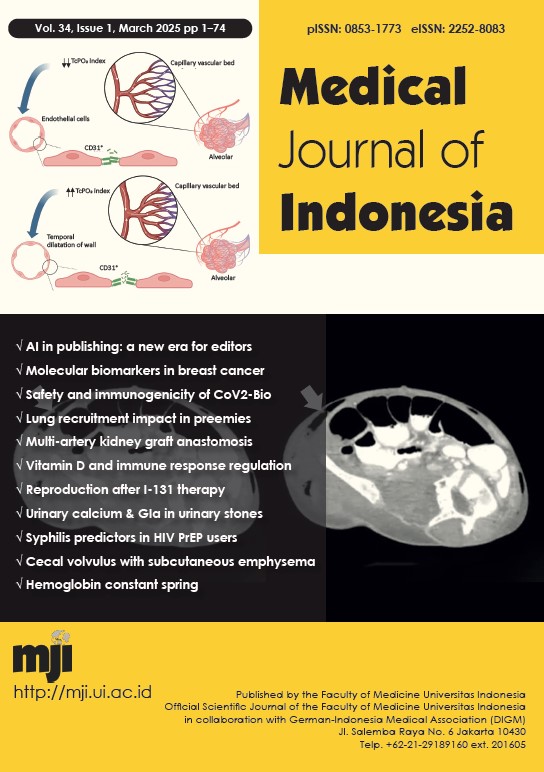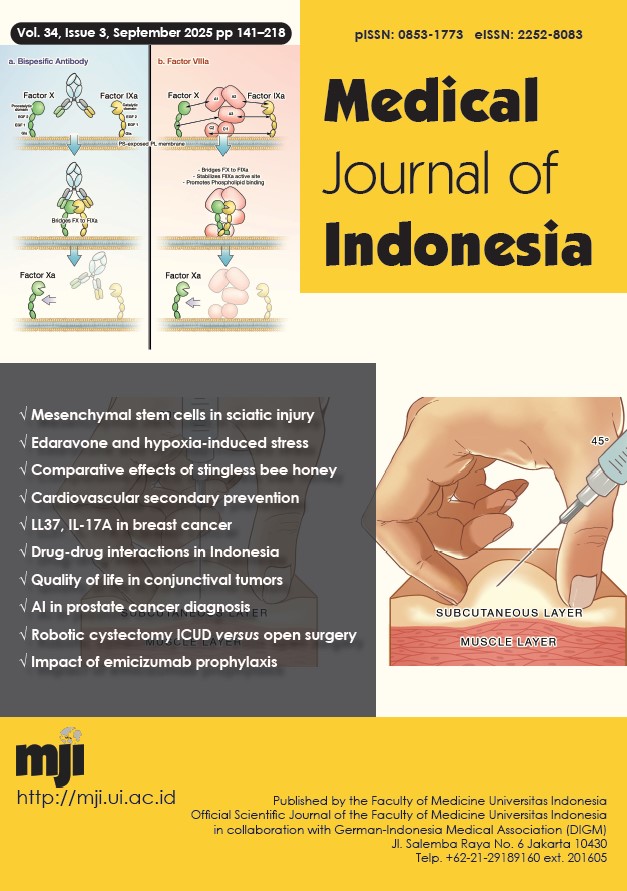Reproductive function after radioactive iodine treatment for differentiated thyroid carcinoma patients: a systematic review
DOI:
https://doi.org/10.13181/mji.oa.257458Keywords:
anti-Mullerian hormone, follicle-stimulating hormone, follicular thyroid carcinoma, luteinizing hormone, papillary thyroid cancer, sperm analysisAbstract
BACKGROUND Thyroid cancer is one of the most prevalent cancers in the endocrine system, with a rapidly rising incidence over the past 3 decades. Treatment for patients with differentiated thyroid cancer (DTC) typically includes surgery, radioactive iodine (I-131) therapy, and levothyroxine (L-T4) suppressive therapy. This study aimed to explore the potential side effects of I-131 therapy on reproductive function in men and women with DTC.
METHODS A literature search was performed using 4 databases (PubMed, ScienceDirect, BioMed Central, and Google Scholar), limited to English publications since 2013. Clinical trials and observational studies that evaluated I-131 in DTC, focused on reproductive-age patients, and included pre-therapy or during-therapy examinations, administered doses, and treatment frequencies of I-131 were selected. The Joanna Briggs Institute Critical Appraisal Checklist is used as a comprehensive evaluation tool, and the literature quality was categorized as high, moderate, and low.
RESULTS The final 17 articles examined the effect of I-131, with 13 focusing on women's reproductive function and 4 on men's. Women who received I-131 therapy can lower anti-Mullerian hormone levels and disrupt menstrual cycles within the first year, and it does not affect subsequent pregnancies. For men, the therapy led to elevated levels of follicle-stimulating hormone and luteinizing hormone, along with changes in sperm quantity, morphology, and motility, which tend to normalize within a year post-therapy.
CONCLUSIONS The reproductive side effects associated with I-131 therapy are generally transient, with most individuals experiencing a return to normal within 1 year following treatment.
Downloads
References
Rossi ED, Pantanowitz L, Hornick JL. A worldwide journey of thyroid cancer incidence centred on tumour histology. Lancet Diabetes Endocrinol. 2021;9(4):193−4. https://doi.org/10.1016/S2213-8587(21)00049-8
Sung H, Ferlay J, Siegel RL, Laversanne M, Soerjomataram I, Jemal A, et al. Global Cancer Statistics 2020: GLOBOCAN estimates of incidence and mortality worldwide for 36 cancers in 185 countries. CA Cancer J Clin. 2021;71(3):209−49. https://doi.org/10.3322/caac.21660
Ferlay J, Ervik M, Lam F, Laversanne M, Colombet M, Mery L, et al. Global Cancer Observatory: cancer today. Lyon: International Agency for Research on Cancer; 2024.
Population I, Population M, Sum P. International Agency for Research on Cancer. WHO Chron. 1969;23(7):323-6.
The Global Cancer Observatory. Cancer incident in Indonesia. International Agency for Research on Cancer. 2020;858:1-2.
The Global Cancer Observatory. Cancer incident in Indonesia. International Agency for Research on Cancer. 2022:1-2.
Ministry of Health of the Republic of Indonesia. [Cancer burden in Indonesia]. Center of Health Data and Information, Ministry of Health of the Republic of Indonesia; 2019. p. 1-16. Indonesian.
Haugen BR, Alexander EK, Bible KC, Doherty GM, Mandel SJ, Nikiforov YE, et al. 2015 American Thyroid Association Management Guidelines for adult patients with thyroid nodules and differentiated thyroid cancer: the guidelines task force on thyroid nodules and differentiated thyroid cancer. Thyroid. 2016;26(1):1−133. https://doi.org/10.1089/thy.2015.0020
Schmidbauer B, Menhart K, Hellwig D, Grosse J. Differentiated thyroid cancer-treatment: state of the art. Int J Mol Sci. 2017;18(6):1292. https://doi.org/10.3390/ijms18061292
Seidlin SM, Marinelli LD, Oshry E. Radioactive iodine therapy: effect on functioning metastases of adenocarcinoma of the thyroid. CA Cancer J Clin. 1990;40(5):299−317. https://doi.org/10.3322/canjclin.40.5.299
Andresen NS, Buatti JM, Tewfik HH, Pagedar NA, Anderson CM, Watkins JM. Radioiodine ablation following thyroidectomy for differentiated thyroid cancer: literature review of utility, dose, and toxicity. Eur Thyroid J. 2017;6(4):187−96. https://doi.org/10.1159/000468927
Canale D, Ceccarelli C, Caglieresi C, Moscatelli A, Gavioli S, Santini P, et al. Effects of radioiodine treatment for differentiated thyroid cancer on testis function. Clin Endocrinol (Oxf). 2015;82(2):295−9. https://doi.org/10.1111/cen.12514
Sioka C, Fotopoulos A. Effects of I-131 therapy on gonads and pregnancy outcome in patients with thyroid cancer. Fertil Steril. 2011;95(5):1552−9. https://doi.org/10.1016/j.fertnstert.2011.01.017
Moola S, Munn Z, Tufanaru C, Aromataris E, Sears K, Sfetcu R, et al. Chapter 7: systematic reviews of etiology and risk. In: Aromataris E, Lockwood C, Porritt K, Pilla B, Jordan Z, editors. JBI manual for evidence synthesis. JBI; 2020. https://doi.org/10.46658/JBIRM-17-06
Adamska A, Tomczuk-Bobik P, Popławska-Kita AB, Siewko K, Buczyńska A, Szumowski P, et al. Assessment of different markers of ovarian reserve in women with papillary thyroid cancer treated with radioactive iodine. Endocr Connect. 2021;10(10):1283−90. https://doi.org/10.1530/EC-21-0187
Yaish I, Azem F, Gutfeld O, Silman Z, Serebro M, Sharon O, et al. A single radioactive iodine treatment has a deleterious effect on ovarian reserve in women with thyroid cancer: results of a prospective pilot study. Thyroid. 2018;28(4):522−7. https://doi.org/10.1089/thy.2017.0442
Hosseini A, Lavasani Z. The effect of radioactive iodine therapy on anti-Müllerian hormone changes in women with thyroid cancer at reproductive age: a prospective study. Middle East Fertil Soc J. 2023;28(24). https://doi.org/10.1186/s43043-023-00147-5
Evranos B, Faki S, Polat SB, Bestepe N, Ersoy R, Cakir B. Effects of radioactive iodine therapy on ovarian reserve: a prospective pilot study. Thyroid. 2018;28(12):1702−7. https://doi.org/10.1089/thy.2018.0129
van Velsen EF, Visser WE, van den Berg SA, Kam BL, van Ginhoven TM, Massolt ET, et al. Longitudinal analysis of the effect of radioiodine therapy on ovarian reserve in females with differentiated thyroid cancer. Thyroid. 2020;30(4):580−7. https://doi.org/10.1089/thy.2019.0504
Acıbucu F, Acıbucu DO, Akkar ÖB, Dokmetas HS. Evaluation of ovarian reserve with AMH level in patients with well-differentiated thyroid cancer receiving radioactive iodine ablation treatment. Exp Clin Endocrinol Diabetes. 2016;124(10):593−6. https://doi.org/10.1055/s-0042-115639
Nies M, Cantineau AE, Arts EG, van den Berg MH, van Leeuwen FE, Muller Kobold AC, et al. Long-term effects of radioiodine treatment on female fertility in survivors of childhood differentiated thyroid carcinoma. Thyroid. 2020;30(8):1169−76. https://doi.org/10.1089/thy.2019.0560
Mittica M, Dotto A, Comina M, Teliti M, Monti E, Giusti M. Cross-sectional and prospective study on anti-Müllerian hormone changes in a cohort of pre-menopausal women with a history of differentiated thyroid cancer. Thyroid Res. 2020;13:1. https://doi.org/10.1186/s13044-020-0075-z
Giusti M, Mittica M, Comite P, Campana C, Gay S, Mussap M. Anti-Müllerian hormone in pre-menopausal females after ablative radioiodine treatment for differentiated thyroid cancer. Endocrine. 2018;60(3):516−23. https://doi.org/10.1007/s12020-017-1510-3
Ko KY, Yen RF, Lin CL, Cheng MF, Huang WS, Kao CH. Pregnancy outcome after I-131 therapy for patients with thyroid cancer: a nationwide population-based cohort study. Medicine (Baltimore). 2016;95(5):e2685. https://doi.org/10.1097/MD.0000000000002685
Kim HO, Lee K, Lee SM, Seo GH. Association between pregnancy outcomes and radioactive iodine treatment after thyroidectomy among women with thyroid cancer. JAMA Intern Med. 2020;180(1):54−61. https://doi.org/10.1001/jamainternmed.2019.4644
Wu JX, Young S, Ro K, Li N, Leung AM, Chiu HK, et al. Reproductive outcomes and nononcologic complications after radioactive iodine ablation for well-differentiated thyroid cancer. Thyroid. 2015;25(1):133−8. https://doi.org/10.1089/thy.2014.0343
Soltani S, Aghaee A, Rasoul Zakavi S, Mottaghi M, Emadzadeh M, Kasaeian Naeini S. Effects of radioiodine therapy on fertility indicators among men with differentiated thyroid cancer: a cohort study. Int J Reprod Biomed. 2023;21(5):387−94. https://doi.org/10.18502/ijrm.v21i5.13472
Bourcigaux N, Rubino C, Berthaud I, Toubert ME, Donadille B, Leenhardt L, et al. Impact on testicular function of a single ablative activity of 3.7 GBq radioactive iodine for differentiated thyroid carcinoma. Hum Reprod. 2018;33(8):1408−16. https://doi.org/10.1093/humrep/dey222
Nies M, Arts EG, van Velsen EF, Burgerhof JG, Muller Kobold AC, Corssmit EP, et al. Long-term male fertility after treatment with radioactive iodine for differentiated thyroid carcinoma. Eur J Endocrinol. 2021;185(6):775−82. https://doi.org/10.1530/EJE-21-0315
Moolhuijsen LM, Visser JA. Anti-Müllerian hormone and ovarian reserve: update on assessing ovarian function. J Clin Endocrinol Metab. 2020;105(11):3361-73. https://doi.org/10.1210/clinem/dgaa513
Kurniawan LB. [The role of anti-Mullerian hormone in the assessment of female reproductive capacity]. Cermin Dunia Kedokteran. 2017;44(5):319-22. Indonesian.
Mishra B, Ripperdan R, Ortiz L, Luderer U. Very low doses of heavy oxygen ion radiation induce premature ovarian failure. Reproduction. 2017;154(2):123−33. https://doi.org/10.1530/REP-17-0101
Deadmond A, Koch CA, Parry JP. Ovarian Reserve Testing. 2022 Dec 21. In: Feingold KR, Anawalt B, Blackman MR, Boyce A, Chrousos G, Corpas E, et al, editors. Endotext [Internet]. South Dartmouth: MDText.com, Inc.; 2000-. Available from: https://www.ncbi.nlm.nih.gov/books/NBK279058/.
Decanter C, Cloquet M, Dassonneville A, D'Orazio E, Mailliez A, Pigny P. Different patterns of ovarian recovery after cancer treatment suggest various individual ovarian susceptibilities to chemotherapy. Reprod Biomed Online. 2018;36(6):711−8. https://doi.org/10.1016/j.rbmo.2018.02.004
Orlowski M, Sarao MS. Physiology, follicle stimulating hormone. StatPearls [e-book]. Treasure Island: StatPearls Publishing; 2024 [cited 2023 Mar 31].
Raju GA, Chavan R, Deenadayal M, Gunasheela D, Gutgutia R, Haripriya G, et al. Luteinizing hormone and follicle stimulating hormone synergy: A review of role in controlled ovarian hyper-stimulation. J Hum Reprod Sci. 2013;6(4):227−34. https://doi.org/10.4103/0974-1208.126285
La Marca A, Argento C, Sighinolfi G, Grisendi V, Carbone M, D'Ippolito G, et al. Possibilities and limits of ovarian reserve testing in ART. Curr Pharm Biotechnol. 2012;13(3):398−408. https://doi.org/10.2174/138920112799361972
Arslan AA, Zeleniuch-Jacquotte A, Lukanova A, Rinaldi S, Kaaks R, Toniolo P. Reliability of follicle-stimulating hormone measurements in serum. Reprod Biol Endocrinol. 2003;1:49. https://doi.org/10.1186/1477-7827-1-49
Kelsey TW, Hua CH, Wyatt A, Indelicato D, Wallace WH. A predictive model of the effect of therapeutic radiation on the human ovary. PLoS One. 2022;17(11):e0277052. https://doi.org/10.1371/journal.pone.0277052
Jacobson MH, Mertens AC, Spencer JB, Manatunga AK, Howards PP. Menses resumption after cancer treatment-induced amenorrhea occurs early or not at all. Fertil Steril. 2016;105(3):765−72.e4. https://doi.org/10.1016/j.fertnstert.2015.11.020
Zhang L, Huang Y, Zheng Y, Cai L, Wen J, Chen G. The effect of I-131 therapy on pregnancy outcomes after thyroidectomy in patients with differentiated thyroid carcinoma: a meta-analysis. Endocrine. 2021;73(2):301−7. https://doi.org/10.1007/s12020-021-02657-6
Lee SY, Pearce EN. Assessment and treatment of thyroid disorders in pregnancy and the postpartum period. Nat Rev Endocrinol. 2022;18(3):158−71. https://doi.org/10.1038/s41574-021-00604-z
Moon S, Yi KH, Park YJ. Risk of adverse pregnancy outcomes in young women with thyroid cancer: a systematic review and meta-analysis. Cancers (Basel). 2022;14(10):2382. https://doi.org/10.3390/cancers14102382
Anderson C, Engel SM, Weaver MA, Zevallos JP, Nichols HB. Birth rates after radioactive iodine treatment for differentiated thyroid cancer. Int J Cancer. 2017;141(11):2291−5. https://doi.org/10.1002/ijc.30917
Cao Q, Zhu H, Zhang J, Li Y, Huang W. Pregnancy outcomes in thyroid cancer survivors: a propensity score-matched cohort study. Front Endocrinol (Lausanne). 2022;13:816132. https://doi.org/10.3389/fendo.2022.816132
Qu N, Itoh M, Sakabe K. Effects of chemotherapy and radiotherapy on spermatogenesis: the role of testicular immunology. Int J Mol Sci. 2019;20(4):957. https://doi.org/10.3390/ijms20040957
Oduwole OO, Peltoketo H, Huhtaniemi IT. Role of follicle-stimulating hormone in spermatogenesis. Front Endocrinol (Lausanne). 2018;9:763. https://doi.org/10.3389/fendo.2018.00763
Esquerré-Lamare C, Isus F, Moinard N, Bujan L. Sperm DNA fragmentation after radioiodine treatment for differentiated thyroid cancer. Basic Clin Androl. 2015;25:8. https://doi.org/10.1186/s12610-015-0024-1
Hussain T, Kandeel M, Metwally E, Murtaza G, Kalhoro DH, Yin Y, et al. Unraveling the harmful effect of oxidative stress on male fertility: a mechanistic insight. Front Endocrinol (Lausanne). 2023;14:1070692. https://doi.org/10.3389/fendo.2023.1070692
Published
How to Cite
Issue
Section
License
Copyright (c) 2025 Aisyah Elliyanti, Zulva Aziza, Yulia Kurniawati, Daan Khambri, Arni Amir, Yusticia Katar

This work is licensed under a Creative Commons Attribution-NonCommercial 4.0 International License.
Authors who publish with Medical Journal of Indonesia agree to the following terms:
- Authors retain copyright and grant Medical Journal of Indonesia right of first publication with the work simultaneously licensed under a Creative Commons Attribution-NonCommercial License that allows others to remix, adapt, build upon the work non-commercially with an acknowledgment of the work’s authorship and initial publication in Medical Journal of Indonesia.
- Authors are permitted to copy and redistribute the journal's published version of the work non-commercially (e.g., post it to an institutional repository or publish it in a book), with an acknowledgment of its initial publication in Medical Journal of Indonesia.






































